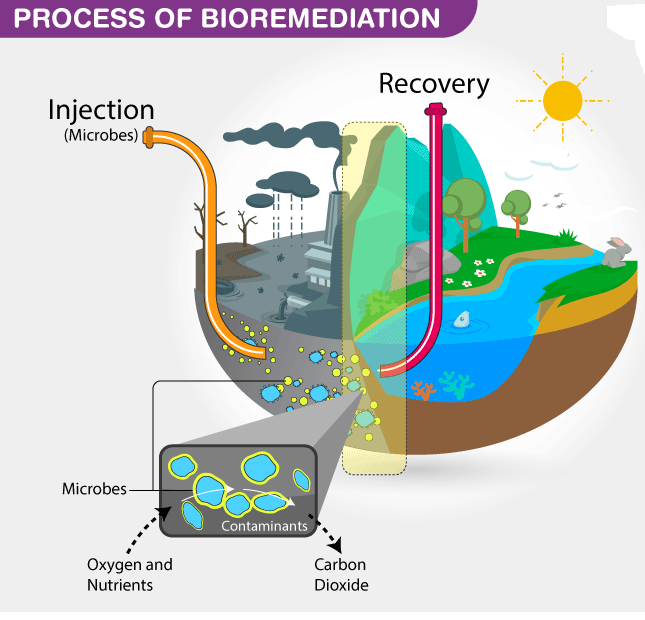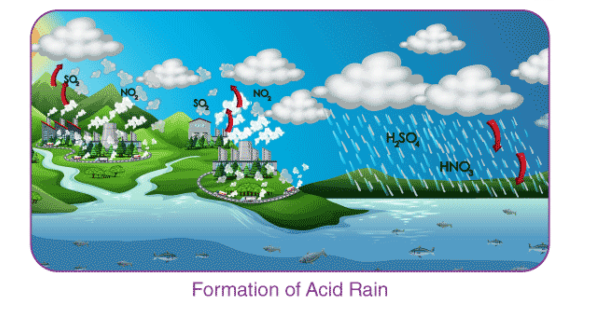Static Quiz 15 June 2022
Quiz-summary
0 of 5 questions completed
Questions:
- 1
- 2
- 3
- 4
- 5
Information
Static Quiz 15 June 2022 for UPSC Prelims
You have already completed the quiz before. Hence you can not start it again.
Quiz is loading...
You must sign in or sign up to start the quiz.
You have to finish following quiz, to start this quiz:
Results
0 of 5 questions answered correctly
Your time:
Time has elapsed
You have reached 0 of 0 points, (0)
Categories
- Not categorized 0%
- 1
- 2
- 3
- 4
- 5
- Answered
- Review
- Question 1 of 5
1. Question
In the context of solving pollution problems, what is/are the advantage/advantages of bioremediation technique?
1. It is a technique for cleaning up pollution by enhancing the same biodegradation process that occurs in nature.
2. Any contaminant with heavy metals such as cadmium and lead can be readily and completely treated by bioremediation using microorganisms.
3. Genetic engineering can be used to create microorganisms specifically designed for bioremediation.Select the correct answer using the code given below:
CorrectAns;- c) 1 and 3 only
Explanation;-
• The 2nd statement is incorrect because bioremediation cannot be completely treated.
• Bioremediation is a process used to treat contaminated media, including water, soil and subsurface material, by altering environmental conditions to stimulate growth of microorganisms and degrade the target pollutants.
• Bioremediation companies that specialize in soil and groundwater use microbes that feed on the hazardous substances for energy, which results in the breakdown of the targeted contaminant. Examples include junkyards, industrial spills, land development, fertilizer use, and more.
• Microbial bioremediation uses microorganisms to break down contaminants by using them as a food source.
• Phytoremediation uses plants to bind, extract, and clean up pollutants such as pesticides, petroleum hydrocarbons, metals, and chlorinated solvents.
• Bioremediation uses micro-organisms to reduce pollution through the biological degradation of pollutants into non-toxic substances. This can involve either aerobic or anaerobic micro-organisms that often use this breakdown as an energy source. Incorrect
IncorrectAns;- c) 1 and 3 only
Explanation;-
• The 2nd statement is incorrect because bioremediation cannot be completely treated.
• Bioremediation is a process used to treat contaminated media, including water, soil and subsurface material, by altering environmental conditions to stimulate growth of microorganisms and degrade the target pollutants.
• Bioremediation companies that specialize in soil and groundwater use microbes that feed on the hazardous substances for energy, which results in the breakdown of the targeted contaminant. Examples include junkyards, industrial spills, land development, fertilizer use, and more.
• Microbial bioremediation uses microorganisms to break down contaminants by using them as a food source.
• Phytoremediation uses plants to bind, extract, and clean up pollutants such as pesticides, petroleum hydrocarbons, metals, and chlorinated solvents.
• Bioremediation uses micro-organisms to reduce pollution through the biological degradation of pollutants into non-toxic substances. This can involve either aerobic or anaerobic micro-organisms that often use this breakdown as an energy source.
- Question 2 of 5
2. Question
Which of the following statemnets regarding Thermal Pollution are correct?
1. Increase in water temperature increases dissolved oxygen in the water.
2. Unlike terrestrial organisms, aquatic organisms are adapted to a uniform steady temperature of the environment.CorrectAns;- b) Only 2
Explanation;-
• The 1st statement is incorrect because Increase in water temperature decreases dissolved oxygen in the water not increases.
• Thermal pollution, sometimes called “thermal enrichment,” is the degradation of water quality by any process that changes ambient water temperature. A common cause of thermal pollution is the use of water as a coolant by power plants and industrial manufacturers.
• Thermal pollution is defined as a sudden increase or decrease in temperature of a natural body of water, which may be ocean, lake, river or pond by human influence. This normally occurs when a plant or facility takes in water from a natural resource and puts it back with an altered temperature.
• Simply put, thermal pollution comes from hot water or cold water being dumped into a body of water. Bodies of water naturally tend to dissipate the heat gained from warm currents, underwater hot springs, and from the sun.
• Over longer time-scales there is no net heat inflow to Earth since incoming solar energy is re-emitted at exactly the same rate.
• Such thermal pollution contributes to global warming until the global temperature has reached a level where this heat is also emitted to space.IncorrectAns;- b) Only 2
Explanation;-
• The 1st statement is incorrect because Increase in water temperature decreases dissolved oxygen in the water not increases.
• Thermal pollution, sometimes called “thermal enrichment,” is the degradation of water quality by any process that changes ambient water temperature. A common cause of thermal pollution is the use of water as a coolant by power plants and industrial manufacturers.
• Thermal pollution is defined as a sudden increase or decrease in temperature of a natural body of water, which may be ocean, lake, river or pond by human influence. This normally occurs when a plant or facility takes in water from a natural resource and puts it back with an altered temperature.
• Simply put, thermal pollution comes from hot water or cold water being dumped into a body of water. Bodies of water naturally tend to dissipate the heat gained from warm currents, underwater hot springs, and from the sun.
• Over longer time-scales there is no net heat inflow to Earth since incoming solar energy is re-emitted at exactly the same rate.
• Such thermal pollution contributes to global warming until the global temperature has reached a level where this heat is also emitted to space. - Question 3 of 5
3. Question
Acid rain is caused by the pollution of environment by
CorrectAns;- d) nitrous oxide and sulphur dioxide
Explanation;-
• Acid rain results when sulfur dioxide (SO2) and nitrogen oxides (NOX) are emitted into the atmosphere and transported by wind and air currents.
• The SO2 and NOX react with water, oxygen and other chemicals to form sulfuric and nitric acids. These then mix with water and other materials before falling to the ground.
• Acid rain can be extremely harmful to forests. Acid rain that seeps into the ground can dissolve nutrients, such as magnesium and calcium, that trees need to be healthy. Acid rain also causes aluminum to be released into the soil, which makes it difficult for trees to take up water.
IncorrectAns;- d) nitrous oxide and sulphur dioxide
Explanation;-
• Acid rain results when sulfur dioxide (SO2) and nitrogen oxides (NOX) are emitted into the atmosphere and transported by wind and air currents.
• The SO2 and NOX react with water, oxygen and other chemicals to form sulfuric and nitric acids. These then mix with water and other materials before falling to the ground.
• Acid rain can be extremely harmful to forests. Acid rain that seeps into the ground can dissolve nutrients, such as magnesium and calcium, that trees need to be healthy. Acid rain also causes aluminum to be released into the soil, which makes it difficult for trees to take up water.
- Question 4 of 5
4. Question
As per the Solid Waste Management Rules, 2016 in India , which one of the following statements is correct?
CorrectAns;- c) The Rules provide for exact and elaborate criteria for the identification of sites for landfills and waste processing facilities.
Explanation;-
• Under the Solid Waste Management, Rules 2016, waste processing facilities will have to be set up by all local bodies having 1 million or more population within two years.
• In case of census towns below 1 million population, setting up common, or stand-alone sanitary landfills by, or for all local bodies having 0.5 million or more population and for setting up common, or regional sanitary landfills by all local bodies and census towns under 0.5 million population will have to be completed in three years.
• Hence, rules provide for exact and elaborate criteria for identification of landfill sites and waste processing facilities. Hence option C is correct.
• Waste generators would now have to now segregate waste into three streams- Biodegradables, Dry (Plastic, Paper, metal, Wood, etc.) and Domestic Hazardous waste (diapers, napkins, mosquito repellants, cleaning agents etc.) before handing it over to the collector. Hence, option a is incorrect.IncorrectAns;- c) The Rules provide for exact and elaborate criteria for the identification of sites for landfills and waste processing facilities.
Explanation;-
• Under the Solid Waste Management, Rules 2016, waste processing facilities will have to be set up by all local bodies having 1 million or more population within two years.
• In case of census towns below 1 million population, setting up common, or stand-alone sanitary landfills by, or for all local bodies having 0.5 million or more population and for setting up common, or regional sanitary landfills by all local bodies and census towns under 0.5 million population will have to be completed in three years.
• Hence, rules provide for exact and elaborate criteria for identification of landfill sites and waste processing facilities. Hence option C is correct.
• Waste generators would now have to now segregate waste into three streams- Biodegradables, Dry (Plastic, Paper, metal, Wood, etc.) and Domestic Hazardous waste (diapers, napkins, mosquito repellants, cleaning agents etc.) before handing it over to the collector. Hence, option a is incorrect. - Question 5 of 5
5. Question
Which of the following are the effects of thermal pollution on fishes?
1. Swimming efficiency declines
2. Decreases their metabolism and affects their growth
3. Resistance to diseases and parasites decreases
4. Reduces biological diversitySelect the correct answer from the following codes
CorrectAns;- c) Only 1,3 and 4
Explanation;-
• Discharge of hot water in water body affects feeding in fishes, increases their metabolism and affects their growth, not decreases that’s y 2nd statement is incorrect.
• Their swimming efficiency declines. Running away from predators or chasing prey becomes difficult.
• Their resistance to diseases and parasites decreases.
• Due to thermal pollution biological diversity is reduced.
• The warm temperature reduces the levels of DO (Dissolved Oxygen) in water.
• The warm water holds relatively less oxygen than cold water.
• The decrease in DO can create suffocation for plants and animals such as fish, amphibians and copepods, which may give rise to anaerobic conditions.
• Thermal pollution is the degradation of water quality by any process that changes ambient water temperature. A common cause of thermal pollution is the use of water as a coolant by power plants and industrial manufacturers.IncorrectAns;- c) Only 1,3 and 4
Explanation;-
• Discharge of hot water in water body affects feeding in fishes, increases their metabolism and affects their growth, not decreases that’s y 2nd statement is incorrect.
• Their swimming efficiency declines. Running away from predators or chasing prey becomes difficult.
• Their resistance to diseases and parasites decreases.
• Due to thermal pollution biological diversity is reduced.
• The warm temperature reduces the levels of DO (Dissolved Oxygen) in water.
• The warm water holds relatively less oxygen than cold water.
• The decrease in DO can create suffocation for plants and animals such as fish, amphibians and copepods, which may give rise to anaerobic conditions.
• Thermal pollution is the degradation of water quality by any process that changes ambient water temperature. A common cause of thermal pollution is the use of water as a coolant by power plants and industrial manufacturers.





